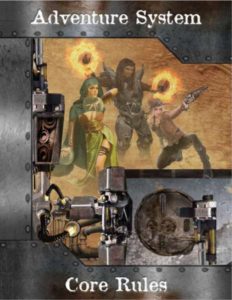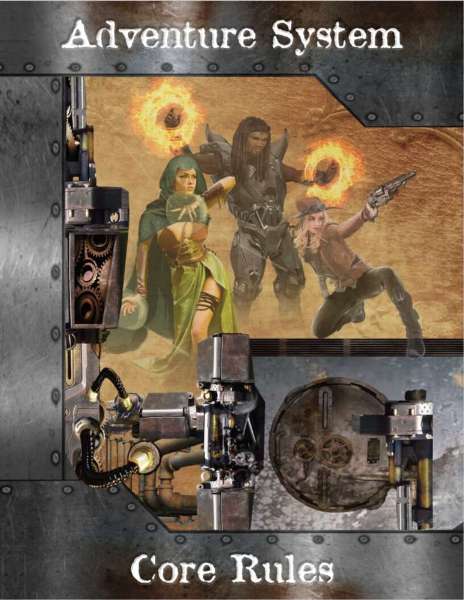
Adventure System
Adventure System is a generic universal tabletop role-playing game written by Philip T. Adams and published by Idyll Creations.
By Aaron T. Huss

Learn more about Adventure System here
Purchase Adventure System here (paid link)
Find other Adventure System posts here
Adventure System is another entry in the generic universal tabletop role-playing game systems with obvious influences from Dungeons & Dragons 5E, Savage Worlds, and some homebrew mechanics. It’s not quite rules-medium but does use an escalating die type like Savage Worlds including the exploding dice, Skills tied to Stats, and Edge-like mechanics called Talents. It then takes the Advantage/Disadvantage system from 5E and creates a magic-system that is D&D-like. It eschews all forms of modifiers and sticks to the Advantage/Disadvantage concept for all cases when a roll should warrant some type of bonus or penalty. This is in addition to a target number that changes with the difficulty of the roll, meaning you never have to incorporate math into your roll; just choose the best or worst die and try to meet the target. Like Savage Worlds it is a class-less system meant to embrace all manner of character concepts. This doesn’t apply 100% to spellcasters as each categorical type has a set of mechanics and Powers they utilize (that’s the D&D influence).
When I first delved into Adventure System, I was really put-off by its design. It clearly is trying to present a large collection of mechanics that sweep the genre spectrum without really going into details and making them a role-playing experience. To me, it was suffering from trying to do too much without the spirit of role-playing to back it up. But I didn’t want to review THAT game and so I stepped back and took a different approach after performing a little bit of research.
What I found is that Adventure System is not a role-playing game, it is a tool kit. It is a complete set of mechanics broken down into their base form. They are not designed to be used standalone and need a setting skin to wrap around them and give them purpose. This is not too dissimilar to games that publish a System Reference Document that strips out the fluff and focuses on the mechanics. By doing this, it presents you with all the fiddly bits, requiring a seasoned GM to use those mechanics to create the game they wish to run. It even includes some scaling skills (most involving equipment costs) that allow the GM to adjust the scale depending on the chosen setting. You can theoretically wrap any genre skin around these mechanics and take off running.
When you look at Adventure System that way, it’s design makes sense and how that design is purposeful. I will say that it focuses very heavily on “Adventure” (probably why it was named as such) and likely doesn’t translate well to dramatic, investigative, or horror-based games quite as well as it does epic fantasy, military sci-fi, western fantasy horror, cyberpunk, and any game that focuses on high action and adventure. To make it easier for GMs to skin their games, it even includes a large list of adversaries, rules for space combat, super science gadgets, a number of character races to choose from, vehicle combat, and three primers to get you going. If you want to know how to skin this tool kit, check-out those primers to get you going. They are an excellent reference!
All in all, I find Adventure System to be well-developed with a good looking book to start from. The cool thing is Idyll Creations effectively sets themselves up for a plethora of potential settings by establishing the core mechanics and adding all the non-mechanical or setting-specific items in a core setting guide (which they call Adventure System Gazetteers). There are two things the book is missing though – a character sheet and a detailed index (the included index is significantly lacking given the number of mechanics involved). Yes you can offer a character sheet as a free download, but it’s good practice to always include it with the core book. It also helps the reader to visualize what a character will look like mechanically at the table.

